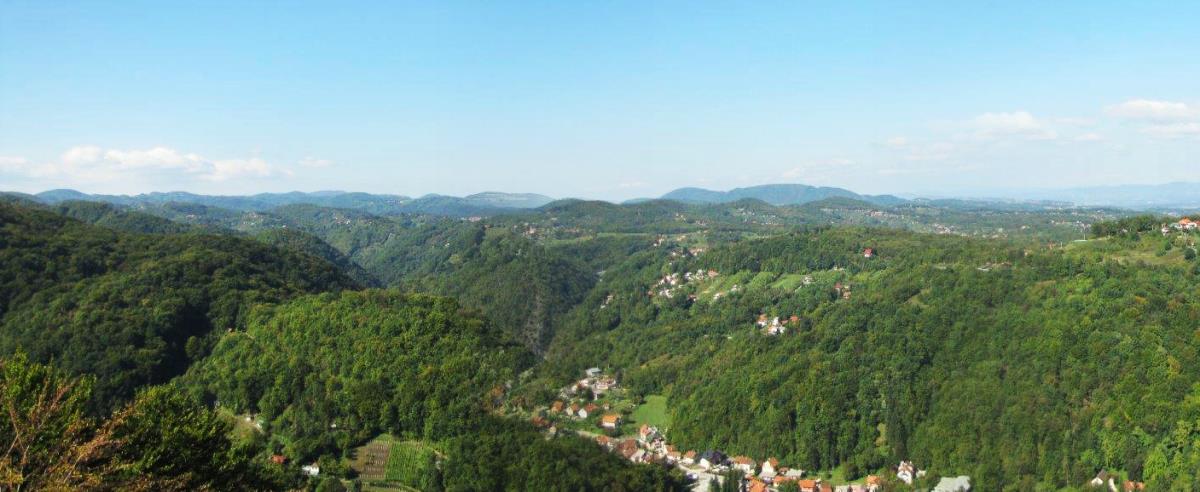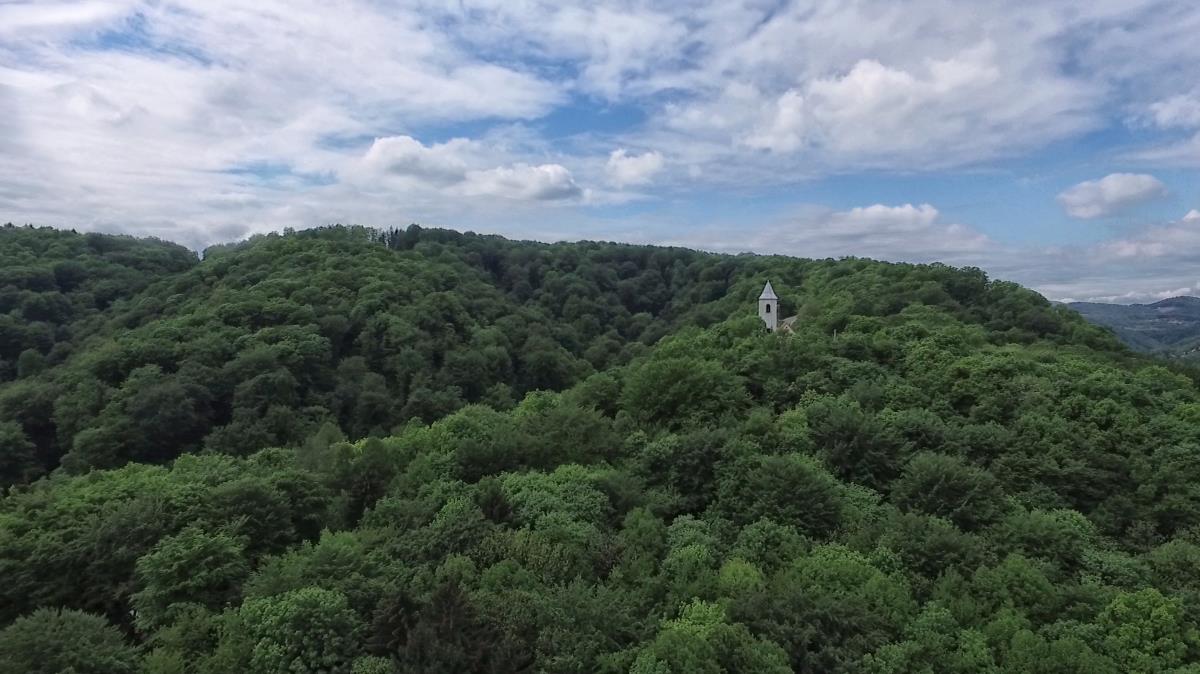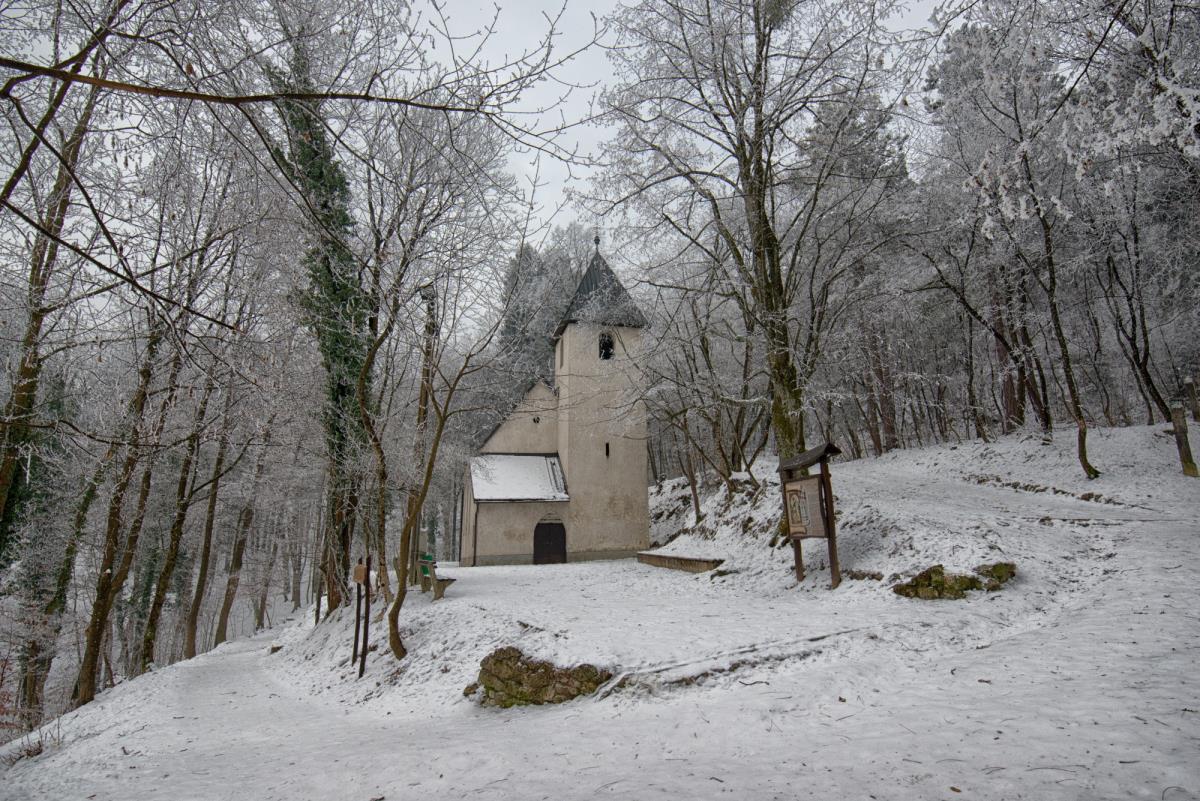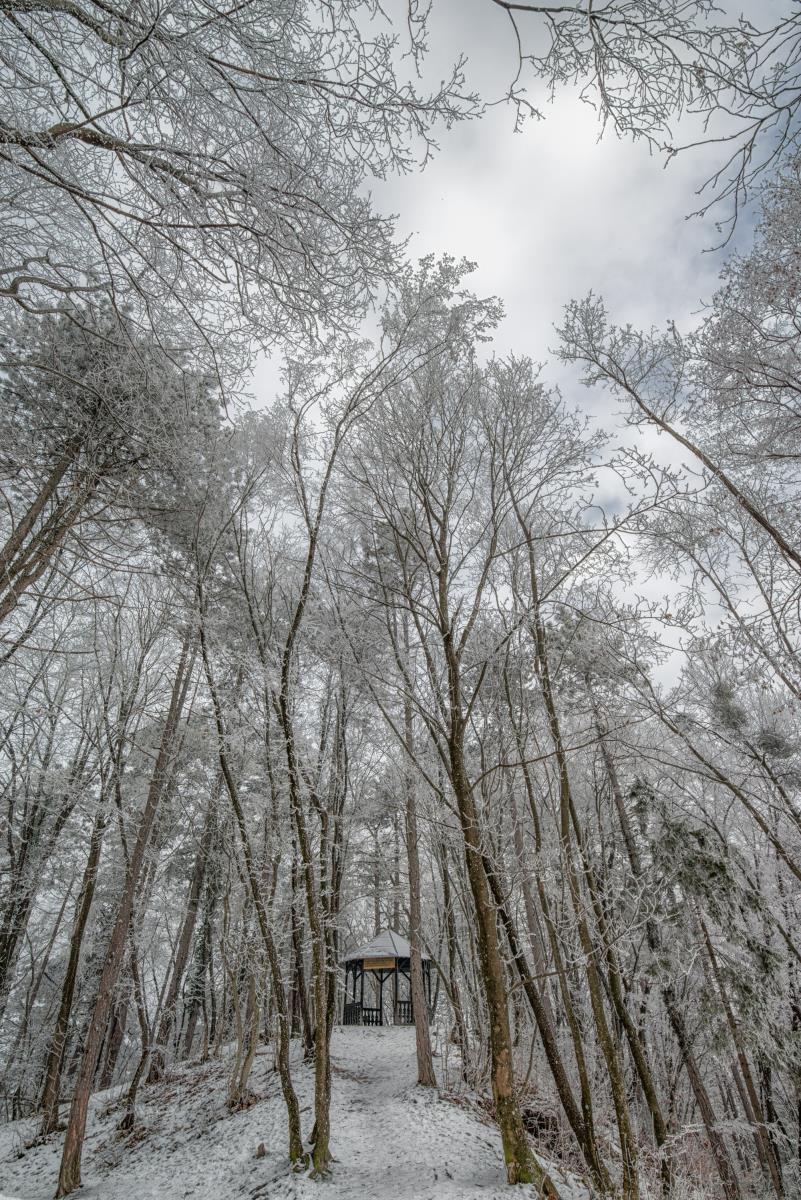TEPEC- PALAČNIK PARK FOREST
Category of protection: park forest
Year of protection: 1970
Location
A green oasis, Tepec–Palačnik Park Forest overlooks the free royal city of Samobor. Located in the Zagreb County in Croatia, Tepec-Palačnik Park Forest provides a beautiful natural panorama of Samobor.
Palačnik hill is located west of Samobor, between the steep valleys of Lipovačka Gradna stream to the north and Rudarska Gradna stream to the south-east. The area is divided in half by Bijeli potok stream, the northern half with the Hajdovčak peak (345m) and the southern half with the Lipice peak (429m). Jarak stream is the border of Tepec hill on the east, and Rudarska Gradna is the hill's border on the west. The hill is separated from Stražnik by a steep valley of Gradna stream, while on the north-east, it gradually descends to Samobor.
Palačnik hill is located west of Samobor, between the steep valleys of Lipovačka Gradna stream to the north and Rudarska Gradna stream to the south-east. The area is divided in half by Bijeli potok stream, the northern half with the Hajdovčak peak (345m) and the southern half with the Lipice peak (429m). Jarak stream is the border of Tepec hill on the east, and Rudarska Gradna is the hill's border on the west. The hill is separated from Stražnik by a steep valley of Gradna stream, while on the north-east, it gradually descends to Samobor.
History
Tepec-Palačnik Park Forest was protected in 1970, although the rich history of this area begins in 19th century when the mayor Ljudevit Šmidhen ordered parts of Tepec and Stražnik to be afforested after severe floods and erosion had hit the area. The following years witnessed the planting of spruce and larch trees from St Mihovil nursery garden in Senj, converting the area into beautiful park forest. The results of these forestry efforts were described in the Journal of Forestry (1909) in which the Croatian government's Forestry administrator, Ante Kera, recommended that the forests of Medvednica be managed following the example of "Anindol natural park".
Parts of Anin-perivoj were named after famous writers and noted citizens of Samobor. The part from the north entrance to "Kostajnina" is called "Preradović promenade", while the grove next to the promenade was named "Šmidhen grove". The part from "Kostajnina" to St. Anne's chapel is called "Vraz promenade", and the part from the chapel to the festivity area (the tancplac) is called "Livadić promenade". All those promenades helped create a captivating image of the area which soon became a favourite visiting place for the citizens of Samobor and Zagreb.
The Park Forest was a favourite retreat of some of the most famous Croatian writers – Petar Preradović, Stanko Vraz, August Šenoa and Antun Gustav Matoš. The poet Marko Vukasović wrote his famous poem "At the Chapel of Saint Anne" in this forest, and a part of Krešo Golik's anthology movie "Tko pjeva zlo ne misli" was shot on this location. The magnificence and mystery of Samobor Old Town captivated both literary and cinematographic imaginations. The writer August Senoa refers to Samobor Old Town in his famous historical novel "Zlatarevo Zlato", while the opening sequence of Jackie Chan's 1987 movie "Armour of God"was filmed among its ruins.
Parts of Anin-perivoj were named after famous writers and noted citizens of Samobor. The part from the north entrance to "Kostajnina" is called "Preradović promenade", while the grove next to the promenade was named "Šmidhen grove". The part from "Kostajnina" to St. Anne's chapel is called "Vraz promenade", and the part from the chapel to the festivity area (the tancplac) is called "Livadić promenade". All those promenades helped create a captivating image of the area which soon became a favourite visiting place for the citizens of Samobor and Zagreb.
The Park Forest was a favourite retreat of some of the most famous Croatian writers – Petar Preradović, Stanko Vraz, August Šenoa and Antun Gustav Matoš. The poet Marko Vukasović wrote his famous poem "At the Chapel of Saint Anne" in this forest, and a part of Krešo Golik's anthology movie "Tko pjeva zlo ne misli" was shot on this location. The magnificence and mystery of Samobor Old Town captivated both literary and cinematographic imaginations. The writer August Senoa refers to Samobor Old Town in his famous historical novel "Zlatarevo Zlato", while the opening sequence of Jackie Chan's 1987 movie "Armour of God"was filmed among its ruins.
Tourism
Samobor's beautiful oasis of peace is best experienced by taking a walk through Tepec-Palačnik Park Forest, the favourite promenade of Croatian literary authors Preradović, Vraz, Šenoa and Matoš. Preradović promenade, Šmidhen grove, Anindol, the tancplac and Vraz promenade are footpaths that keep many secrets. Perhaps Smidhen grove will inspire you too to pen a delightful line to your loved one. A part of Krešo Golik's cult movie "Tko pjeva zlo ne misli" was shot in Anin perivoj. On the tancplac you too can dance with your Mr Fulir…
Only 2 km from the main Samobor square is a 14m high Tepec observation deck (Anindol pyramid) from where you can admire one of the most beautiful vistas of Samobor, Zagreb, Medvednica and Samobor mountains.
From the observation deck you can see the remains of Samobor Old Town (Stari grad), inviting you to discover it. Although only ruins of the town remain, Samobor Old Town still attracts visitors and retains the allure it had in the long course of its history when it protected Samobor from the enemy armies.
Only 2 km from the main Samobor square is a 14m high Tepec observation deck (Anindol pyramid) from where you can admire one of the most beautiful vistas of Samobor, Zagreb, Medvednica and Samobor mountains.
From the observation deck you can see the remains of Samobor Old Town (Stari grad), inviting you to discover it. Although only ruins of the town remain, Samobor Old Town still attracts visitors and retains the allure it had in the long course of its history when it protected Samobor from the enemy armies.
Natural values
"Tepec-Palačnik" Park Forest with a total area of 308.45 ha was first put on the protected list in 1970. In geological terms, Tepec is built of sedimentary rocks, mostly of Triassic dolomite, and to a lesser extent, in the north-eastern part towards Giznik, of Miocene limestones. Around the highest point of Tepec (394m), on silicate substrates, are found forests of sessile oaks (Quercus petraea) and sweet chestnut (Castanea sativa).On the steep western slopes towards the Rudarska Gradna tream there are beech forests (Fagetumcroaticum) with maple (Acer sp.) and European hornbeam (Carpinusbetulus).
The Palačnik hill is made of Triassic dolomite and covered with a beech forest (Fagetumcroaticum). Sessile oaks (Quercus petraea) can be found in the central part with conifers, spruce and pine further to the west. A chestnut forest (Castanea sativa) formed in the vicinity of Palačnik village. The entire area is characteristically covered in forest, the only exception being the ruins of the Samobor Old Town whose walls are covered with smaller plants more suited to life on the scarce soil between the stone blocks.
The presence of 73 bird species has been recorded in the Tepec area. They include the goshawk, the common buzzard, the black woodpecker, the long-eared owl, the great spotted woodpecker, the white wagtail and the Eurasian wren. The most interesting discovery is the presence of the wallcreeper, a species commonly found in high mountainsand inhabiting rocks and cliffs above the tree line. This species usually moves to lower elevations during the winter period. It is present in the area of the Old Town ruins where it remains until the first high snow.
The Palačnik hill is made of Triassic dolomite and covered with a beech forest (Fagetumcroaticum). Sessile oaks (Quercus petraea) can be found in the central part with conifers, spruce and pine further to the west. A chestnut forest (Castanea sativa) formed in the vicinity of Palačnik village. The entire area is characteristically covered in forest, the only exception being the ruins of the Samobor Old Town whose walls are covered with smaller plants more suited to life on the scarce soil between the stone blocks.
The presence of 73 bird species has been recorded in the Tepec area. They include the goshawk, the common buzzard, the black woodpecker, the long-eared owl, the great spotted woodpecker, the white wagtail and the Eurasian wren. The most interesting discovery is the presence of the wallcreeper, a species commonly found in high mountainsand inhabiting rocks and cliffs above the tree line. This species usually moves to lower elevations during the winter period. It is present in the area of the Old Town ruins where it remains until the first high snow.
Sights
Samobor Old Town
In the Tepec forest are the remains of Samobor old town, dating back to 13th century. Numerous kings and nobles ruled in Samobor old town through the centuries, starting with the Czech king Ottokar who built the town in 1268 on the site of a pre-existing building. Arpadović, Babonić, Anjou, Frankopan, Erdödyji, counts of Celje, Matija Korvin, Ungnadi, Gruber, Auersperg, Kulmer, Kiepachi, Alnochii and Montecuccoli are the noble families who inhabited and built Samobor old town through the centuries. From the initial Romanesque-gothic burg with a large tower, the old town eventually acquired late Gothic-renaissance features and in the late 17th and early 18th century became a Baroque castle.
The Chapel of Saint Anne
The Chapel of Saint Anne, mentioned in a 1937 poem by Marko Vukasović as a meeting place "At the Chapel of Saint Anne", is located in the tranquil forest of Tepec.The youngest Baroque sacral edifice in Samobor, the chapel is mentioned first time in 1677 although it is assumed that the work on its construction started earlier. The chapel was built by the lady of Samobor old town, Ana Elizabeta Auersperg. The Chapel of Saint Anne is nestled among slender spruce trees inviting passers-by to experience its serenity.
In the Tepec forest are the remains of Samobor old town, dating back to 13th century. Numerous kings and nobles ruled in Samobor old town through the centuries, starting with the Czech king Ottokar who built the town in 1268 on the site of a pre-existing building. Arpadović, Babonić, Anjou, Frankopan, Erdödyji, counts of Celje, Matija Korvin, Ungnadi, Gruber, Auersperg, Kulmer, Kiepachi, Alnochii and Montecuccoli are the noble families who inhabited and built Samobor old town through the centuries. From the initial Romanesque-gothic burg with a large tower, the old town eventually acquired late Gothic-renaissance features and in the late 17th and early 18th century became a Baroque castle.
The Chapel of Saint Anne
The Chapel of Saint Anne, mentioned in a 1937 poem by Marko Vukasović as a meeting place "At the Chapel of Saint Anne", is located in the tranquil forest of Tepec.The youngest Baroque sacral edifice in Samobor, the chapel is mentioned first time in 1677 although it is assumed that the work on its construction started earlier. The chapel was built by the lady of Samobor old town, Ana Elizabeta Auersperg. The Chapel of Saint Anne is nestled among slender spruce trees inviting passers-by to experience its serenity.
Known about the unknown
A natural phenomenon, a stone rock beneath the Samobor Old Town inspired a legend about the Samobor turtle. According to a 15th century legend, the turtle was created by Barbara, the countess of Celje, the ruler of the Old Town. Known as the Black Queen, Barbara of Celje was involved with alchemy and the occult, and she created a giant turtle to terrorize the citizens of Samobor. The monster would come to town asking for small children to be sacrificed to her until the only child remaining was the child of the queen herself. When the voracious monster turned to eat the queen's child, Barbara pleaded with her former enemies to pray for the salvation of her child. The citizens of Samobor agreed but asked that in return the Black Queen leaves the city. When the queen agreed, a thunderbolt struck the monster, and it turned to stone.
Open for visitors
- Opening hours: 0-24h
- Arrival notification: Not required
- Additional information:
Enter the ruins of the old town at your own risk.
This area is managed by Zeleni prsten Public institution of Zagreb County
- Address: 151. Samoborske brigade HV 1, Samobor, Hrvatska
- Phone: +385 (0)16111 552
- Web page: https://zeleni-prsten.hr/
- Social networks:
https://www.facebook.com/zeleniprsten
https://www.instagram.com/zeleni_prsten/










